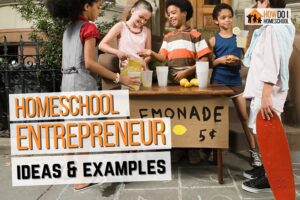When I first heard about lapbooking, I thought it was a great concept. It’s a way parents can inject fun into a boring curriculum and get children to be more hands-on. Lapbooking can stimulate children to think differently. It’s also a great way of gently testing their knowledge of the material you’ve just covered.

I hope you enjoy reading this blog post. If you want to do my course on how to homeschool, click here.
Let’s learn more about it below.
Affiliate links used in this article help support my little homeschool family. Thanks in advance 🙂
What is Lapbooking
Lapbooking is a homeschooling method that involves children making mini-books of the concepts they learn in their lessons. The mini-books are collated in a larger folder of other mini-books on the same topic.
What is an Example of Lapbooking?
An example of Lapbooking would be if children were to make a mini-book of the:
- animals that live around a particular geographical area (i.e., Dodo, Anteater, Badger)
- gods worshipped in ancient times (i.e. Zeus, Hera, Aphrodite) – see the picture below for this example
- weather patterns throughout the year (i.e., flooding, drought, desert, and forest regions)
Then, they would collate all these smaller books into a larger book or folder named ‘Studies about Egypt.’
And this would be your lapbook! (Here are some helpful Pinterest examples of Egyptian lapbooks.)
What is the Purpose of Lapbooking?
The purpose of lapbooking is to:
- gently test children’s knowledge of the subject,
- reinforce concepts taught in books or textbooks, and
- get children to use their hands as they learn.
As such, these mini-books make lessons more enjoyable and change the pace a little more so children can learn differently.
How to Lapbook
You can lapbook by following these steps:
- Grab a book or a folder with several thick papers inside (either thick paper or cardboard).
- Name the book with colorful markers (i.e., Studies of Egypt)
- Find some printer paper. Cut these into rectangular shapes of around 10cm x 20 cm.
- Place these rectangular pieces on each other and fold them in half.
- Staple along the fold.
- You’ve now made a mini-book.
- Get children to fill these books with the concepts students learn and glue them into your book/folder to make a larger book.
You can also paste in relevant pictures with captions beneath them. Or you can make a little pocket and get children to cut out notes or pictures and put these into these pockets.
What is the Place of Lapbooking in a Homeschool Situation?
Many homeschool curricula use this method to help children reinforce concepts they learn in their lessons.
Indeed, I first learned about lapbooking when I studied the eclectic curriculum called Tapestry of Grace.
Along with Charlotte Mason, Classical and Unit Study methods, they used this method to help children learn new things and consolidate old lessons.
Lapbooking can also be an excellent method to learn a subject no one teaches.
For example, if your child was interested in Boeing airplanes, you could get them to make a lapbook of:
- the different versions of Boeings (747, 737, 787 max),
- photographs of Boeings
- how airplanes work
- a black box, and how they work
Lapbooks are a great way to collate information on exciting topics with no written subject available.
Lapbooks from Knowledge Box Central
Another way to incorporate some fun into your homeschool is by using purchased lapbooks.
These lapbooks can be a beautiful keepsake and a great way of reviewing material after completing a course.
These are a great option if you don’t have time to get your children started with a lap book!
You may be a working homeschool mom and need a break.
These are a great option!
Buy lapbooks from Knowledge Box Central here.
What are Some Homeschool Methods That Use Lapbooking?
A lot of homeschool methods use lapbooks in their curriculums.
This is especially common in Unit Studies homeschool curriculum programs.
Because unit studies learn by topics rather than subjects, lapbooks are a great way to summarize and review the topic in the future.
Charlotte Mason curricula also sometimes employ lapbooks to help children learn.
Potential Downsides to Labooking
If you have older children, they can do a lot of labooking activities on their own.
But, a downside of lapbooking, especially if you want an easy homeschool, is that it takes time to organize materials.
Parents have to like crafting and sitting with children to do these.
If children are very young, this sort of learning can consume time.
Yes, it’s excellent for interest-based learning.
But it’s heavy on mom’s time.
Buying lapbooks is an excellent way to get past this, but a fair bit of cutting and pasting is still involved!
Lapbook Ideas
Here are 30 fun lapbooking ideas across different subjects and themes:
- Historical Events: Create a lapbook detailing a significant historical event such as World War II, the American Revolution, or the Renaissance.
- Biographies: Design a lapbook about a famous historical figure or a contemporary leader. Include information about their life, achievements, and contributions.
- Science Experiments: Make a lapbook to document and illustrate different science experiments, including hypotheses, methods, and results.
- Animals: Explore the world of animals by creating a lapbook featuring different species, habitats, behaviors, and adaptations.
- Space Exploration: Craft a lapbook focusing on space exploration, including information about planets, stars, galaxies, and astronauts.
- Literature Analysis: Analyze a favorite book or literary work by creating a lapbook that includes summaries, character analyses, themes, and memorable quotes.
- Geography: Explore different countries, continents, and geographic features by creating a lapbook that includes maps, facts, and cultural information.
- Math Concepts: Reinforce mathematical concepts such as addition, subtraction, multiplication, and division through interactive lapbook activities and games.
- Bible Characters: List the name of 10 of your children’s favorite bible persons and make a mini story for each of them telling what they did and how.
- Language Arts Skills: Create a lapbook to practice language arts skills such as grammar rules, vocabulary words, parts of speech, and writing prompts.
- Weather Patterns: Investigate weather patterns, climate zones, and natural disasters by designing a lapbook with information and illustrations.
- Environmental Issues: Raise awareness about environmental issues by creating a lapbook that addresses topics such as pollution, conservation, and sustainability.
- Art Techniques: Explore different art techniques and styles by creating a lapbook that showcases various artists, art movements, and creative processes.
- Music Appreciation: Learn about different genres of music, famous composers, and musical instruments by creating a lapbook with audio clips, images, and facts.
- Famous Landmarks: Explore famous landmarks and monuments from around the world by creating a lapbook that includes historical background, architectural details, and interesting facts.
- Cultural Celebrations: Celebrate cultural diversity by creating a lapbook that highlights different holidays, festivals, and traditions from around the world.
- Health and Nutrition: Educate about healthy living and nutrition by creating a lapbook with information about food groups, dietary guidelines, and exercise routines.
- Government and Civics: Explore the principles of democracy, the branches of government, and civic responsibilities by creating a lapbook with informative diagrams and charts.
- Inventions and Discoveries: Investigate groundbreaking inventions and scientific discoveries by creating a lapbook that highlights inventors, patents, and technological advancements.
- Ocean Life: Dive into the depths of the ocean by creating a lapbook that features marine ecosystems, ocean creatures, coral reefs, and conservation efforts.
- Agriculture and Farming: Learn about agriculture and farming practices by creating a lapbook that includes information about crops, livestock, machinery, and rural life.
- Bible Proverbs: Explore the Proverbs and how each one pertains to our life. Get children to write stories about how a proverb might play out in a persons life for good or evil.
- Mythology and Folklore: Explore myths, legends, and folklore from different cultures by creating a lapbook that includes stories, characters, and symbolic motifs.
- Civil Rights Movements: Investigate civil rights movements throughout history by creating a lapbook that includes key events, influential leaders, and social justice issues.
- Medieval Times: Journey back to medieval times by creating a lapbook that explores knights, castles, feudalism, and medieval society.
- Habitats and Ecosystems: Explore diverse habitats and ecosystems by creating a lapbook that showcases different biomes, flora, fauna, and ecological relationships.
- Solar System: Explore the solar system by creating a lapbook that includes information about the sun, planets, moons, asteroids, and comets.
- Human Body Systems: Learn about the human body and its systems by creating a lapbook that includes anatomy diagrams, organ functions, and health tips.
- Explorers and Navigators: Investigate famous explorers and navigators by creating a lapbook that highlights their voyages, discoveries, and contributions to geography.
- Famous Artists: Explore the works of famous artists by creating a lapbook that includes biographical information, artistic styles, and iconic paintings.
- Colonial America: Explore colonial America by creating a lapbook that includes information about early settlements, colonial life, and interactions with Native Americans.
- Good Character: Explore great habits children can develop. Or explore bad habits children can develop. Then, explore the consequences each action brings.
- Ancient Civilizations: Dive into ancient civilizations such as Egypt, Greece, Rome, or Mesopotamia by creating a lapbook that includes information about culture, religion, architecture, and daily life.
These lapbooking ideas can be customized and adapted to suit different age groups, learning styles, and interests. Enjoy the creative process!
Extra Homeschool Help
If you’re starting out on your homeschool journey or you just love homeschool curricula of all sorts, join my How to Homeschool YouTube channel!
I teach parents how to homeschool with confidence, and I love it!
Or you can join the Homeschool Parenting Program, which is a foundational course for new homeschool parents which will give them confidence to homeschool right from the start. Join it here.
Conclusion
If you want to get into hands-on learning, cement concepts in a fun way, and document some of the progress your children make, get them into lapbooking. It’s a lot of fun cutting and pasting and a great way to have an enjoyable time together!





